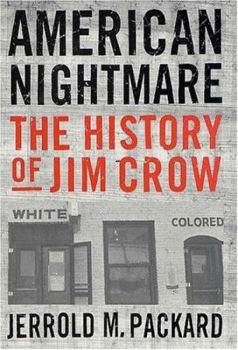American Nightmare: The History of Jim Crow
Select Format
Select Condition 
Book Overview
For a hundred years after the end of the Civil War, a quarter of all Americans lived under a system of legalized segregation called Jim Crow. Together with its rigidly enforced canon of racial "etiquette," these rules governed nearly every aspect of life - and outlined draconian punishments for infractions.The purpose of Jim Crow was to keep African Americans subjugated at a level as close as possible to their former slave status. Exceeding even South...
Format:Hardcover
Language:English
ISBN:0312261225
ISBN13:9780312261221
Release Date:February 2002
Publisher:St. Martin's Press
Length:304 Pages
Weight:1.28 lbs.
Dimensions:1.2" x 6.4" x 9.6"
Customer Reviews
3 ratings
Eye Opening Book About Jim Crow South
Published by Thriftbooks.com User , 17 years ago
I was brought up in the rural Louisiana south in the 50's. I always wondered about the "White Only / Colored Only" signs, but never knew until I read this book that they were the result of LAWS and not just local custom. The book is factual but interesting. I came away with a lot better realization of how our society was back then. I gave a copy to my brother; he likewise appreciated the book and found it very informative.
True History
Published by Thriftbooks.com User , 22 years ago
The African American has come a long way, or have they? American Nightmare: The History of Jim Crow by Jerrold M. Packard chronicles the very beginnings of the well know, well established Jim Crow system developed in America decades ago. It was a successful system that put into place, laws which kept the African America a second-class citizen even after slavery was abolished. The purpose was to keep sacred and separate any person of color from becoming equal to the white establishment. American Nightmare is an intense historical recollection of Jim Crow years and the plight of the African American. It is a powerful book and Mr. Jerrold very skillfully details in length the root causes, the rationale, the religious and educational aspects, and the dismantling of the vicious Jim Crow system. This book reminds us how devastating this era was and that we should never allow anything resembling this degrading system to ever surface again.I applaud Jerrold M. Packard for producing a book that reminds us all of who we are and where we are today. It is an historical and educational guide of the past, present, and for the future of America to strengthen its human rights policies to insure that all citizens are treated equal. As mentioned earlier, the African American has come a long way or have they? Read American Nightmare: The History of Jim Crow and you decide for yourself.Reviewed by Kalaani
A History of a Horror, and Victory Over It
Published by Thriftbooks.com User , 22 years ago
_American Nightmare: The History of Jim Crow_ (St. Martin's) by Jerrold Packard is in many ways a difficult book to read, for while the picayune and artificial rules by which blacks were kept in their place in the South are now so obviously stupid, they were for years maintained by whites and endured by blacks. As Packard says, this is a history of the worst of America, an examination of how poorly it had lived up to the ideals for which it really stands. There is also inspiration here, in the courage of black Americans who were able to achieve basic justice out of oppression. There is also some need for congratulation; we have not achieved harmony between the races, but the egregious practices described here will never come back.There was hardly a part of society that the Jim Crow laws or customs did not control. Naturally, the rules were different in different places (leading to confusion for black people who traveled anywhere), but the examples given in the book will remind Southerners who are old enough just how strange the system was. There might be two lines for movie tickets, if blacks were allowed in the theater, and if they were, they had to sit upstairs. In North Carolina and Florida, officials insisted that schoolbooks used by blacks had to be stored in different spaces than those used by whites. Sometimes a town library might have a room for black users, but often they were barred from the library altogether. A 1900 Mississippi law allowed black corpses to be dug up from white cemeteries and sent to black ones. Whereas slaves could have gone to white churches, within a specified section, free blacks were barred from white congregations, who were told that such discrimination was decreed by God himself. Streetcar and bus conductors were given police power to enforce seating regulations; in some places, the front of a streetcar was regarded as the place for inferiors, prompting a white person to remark on the variant: "It isn't important which end of the car is given to a nigger. The main point is that he must sit where he is told." Of course Jim Crow ruled on housing, schooling, and voting. Eventually, Packard demonstrates, the economic and social forces from World War II, and the glare of international embarrassment, provided important reasons for the nation to make changes. Whatever forms of racism remain, Jim Crow is dead, killed by hundreds of heroic acts large and small. Thus Packard's final chapters are inspiring, showing Rosa Parks refusing to surrender a bus seat to a white passenger in 1955, and the resultant Montgomery, Alabama, bus boycott. A preacher named Martin Luther King, Jr., was launched into leadership by the boycott, which grew into a movement of freedom riding, lunch counter sit-ins, and voting registration drives. It was no easy victory; though the blacks were constantly accused of violence, they were the victims, not the culprits, of church bombings, lynchings, and police dog attacks. Equal trea






